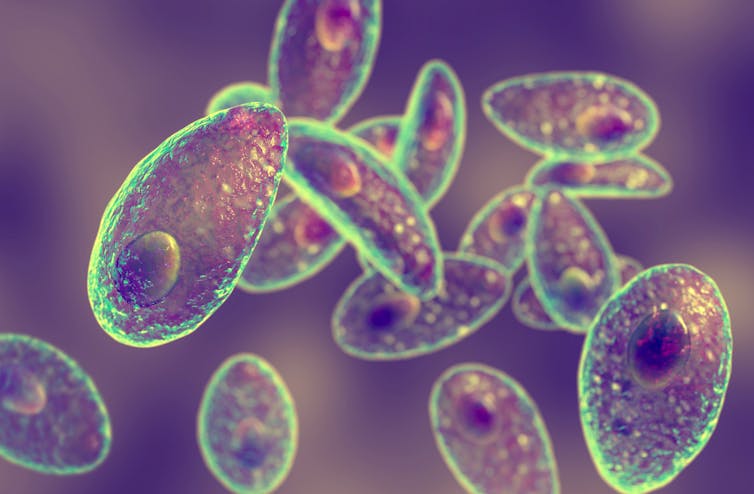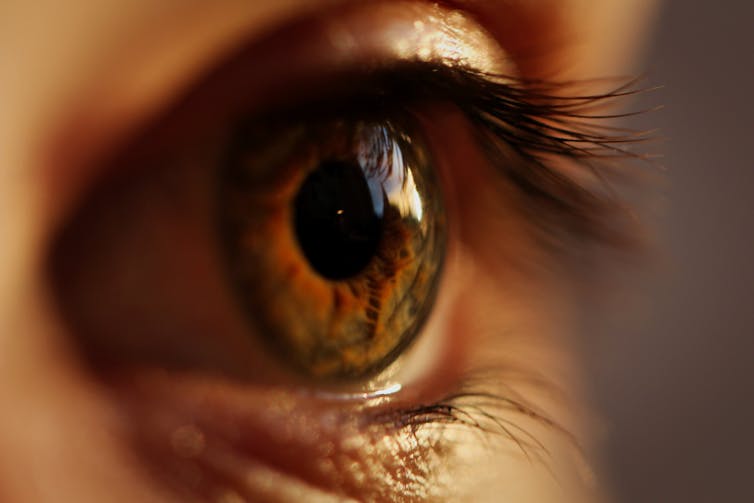
According to the WHO over 1 million people in the European area alone become infected by it and, according to Professor Justine R. Smith, Professor of Eye & Vision Health, Flinders University, Australia and Assistant professor João M. Furtado, Assistant professor of Ophthalmology, Universidade de São Paulo, Brazil, writing in The Conversation, 30%-50% of the world's population could be infected by it, making it the most successful pathological organism known. Once infected a person carries it for life and it is one of the most zoonotic organisms, capable of infected almost any animal or bird.
According to the WHO Toxoplasmosis fact sheet:
Key facts
- Toxoplasmosis is a zoonotic infection caused by the parasite Toxoplasma gondii with a wide range of clinical syndromes in humans.
- World Health Organization (WHO) estimates that every year there are over 1 million cases of toxoplasmosis in the European region caused by contaminated food.
- For women, infection with Toxoplasma during or just before pregnancy can be particularly serious resulting in miscarriage, stillbirth or child disability.
- Persons with compromised immune systems are also at a higher risk of developing a severe form of toxoplasmosis.
- Cats are the primary hosts of the parasite, and they can excrete oocysts with their feces in the environment, which then can infect other animals and humans.
- Humans can get infected in different ways, the foodborne route being important. This can occur through consumption of undercooked infected meat, or through fruits and vegetables contaminated by oocysts in the environment.
- To prevent foodborne toxoplasmosis, one should follow the WHO Five Keys to Safer Food.
So clearly, creationists have a great deal to be proud of there, and there is more great stuff to come!
As Professor Justine R. Smith and Assistant professor João M. Furtado say in their article in The Conversation, reproduced in full here as a condition of the Creative Commons licence under which it is made available for reprinting:
I also devote several pages in my popular, illustrated book, The Malevolent Designer: Why Nature's God is not Good (pp. 23-26) to Toxoplasma gondii, especially the way it manipulates its host, such as giving infected rats a liking for cats and infected chimpanzees being morbidly attracted to the smell of leopard urine. The mood changes humans experience when infected could be an echo of how the parasite manipulated us before we diverged from chimpanzees. Getting its host killed and eaten is a brilliant way for the parasite to infect new victims, of course.One in three people are infected with Toxoplasma parasite – and the clue could be in our eyes
Justine R. Smith, Flinders University and João M. Furtado, Universidade de São Paulo
Toxoplasma gondii is probably the most successful parasite in the world today. This microscopic creature is capable of infecting any mammal or bird, and people across all continents are infected. Once infected, a person carries Toxoplasma for life. So far, we don’t have a drug that can eradicate the parasite from the body. And there is no vaccine approved for use in humans.
Across the world, it’s estimated 30–50% of people are infected with Toxoplasma – and infections may be increasing in Australia. A survey of studies conducted at blood banks and pregnancy clinics across the country in the 1970s put the infection rate at 30%. However, a recent Western Australian community-based study found 66% of people were infected.
The disease caused by this parasite can scar the back of the eye. Our new research looked for signs of disease in otherwise healthy people and found a significant number bore the mark of Toxoplasma.
We don’t just get it from cats
The cat is the primary host for Toxoplasma.
Cats catch the parasite when they eat infected prey. Then, for a couple of weeks, they pass large numbers of parasites in their faeces in a form that can survive for long periods in the environment, even during extreme weather.
When the faeces are ingested by livestock while grazing, parasites lodge in the muscle and survive there after the animals are slaughtered for meat. Humans can become infected by eating this meat, or by eating fresh produce or drinking water soiled by cats. It is also possible for a woman infected for the first time during pregnancy to pass the infection to her unborn child.
While infection with Toxoplasma is extremely common, the most important health statistic is the rate of the disease caused by the infection, which is called toxoplasmosis.
How it affects the eye
Toxoplasma really likes the retina, the multi-layered nerve tissue that lines the eye and generates vision. Infection can cause recurring attacks of retinal inflammation and permanent retinal scarring. This is known as ocular toxoplasmosis.
Contrary to much that is written about ocular toxoplasmosis, medical research shows this condition usually affects healthy adults. However, in aged persons or people with a weakened immune system, or when contracted during pregnancy, it can be more severe.
An attack of active inflammation causes “floaters” and blurred vision. When the inflammation progresses to scarring, there may be permanent loss of vision.
In a study of patients with ocular toxoplasmosis seen at a large ophthalmology clinic, we measured reduced vision to below driving level in more than 50% of eyes, and 25% of eyes were irreversibly blind.
How many eyes?
Ophthalmologists and optometrists are quite familiar with managing ocular toxoplasmosis. But the extent of the problem is not widely recognised, even by the medical community. The number of Australians with ocular toxoplasmosis had never been measured, until now.
We wanted to investigate the prevalence of ocular toxoplasmosis in Australia, but we knew it would be challenging to get funding for a major survey of this neglected disease. So, we used information collected for a different purpose: as part of the Busselton Healthy Ageing Study, retinal photographs were taken from more than 5,000 baby boomers (born 1946–64) living in Busselton, Western Australia. The photographs were gathered to look for other eye diseases, macular degeneration and glaucoma.
By screening these retinal photographs, we estimated the prevalence of ocular toxoplasmosis at one in 150 Australians. This might seem surprisingly common, but it fits with the way people catch Toxoplasma.
In addition to pet cats, Australia has huge populations of feral cats. And Australia is home to a lot of farmland, including over 50% of the global organic farming area.
Most importantly, many Australians like to eat their red meat rare, putting them at real risk.
How the condition is treated
To diagnose ocular toxoplasmosis, a retina examination is necessary, ideally with the pupils dilated.
The retinal lesion is easy to spot, because of the way Toxoplasma activates retinal cells to produce certain proteins, and an ophthalmologist or optometrist can immediately recognise the appearance. Often a blood test is also performed to make the diagnosis.
If the condition is mild, the doctor may let the body’s own immune system control the problem, which takes a few months. However, usually a combination of anti-inflammatory and anti-parasitic drugs is prescribed.
Stopping the spread
Toxoplasma infection is not curable, but it can be prevented. Meat sold in Australian supermarkets may harbour Toxoplasma__. Cooking meat to an internal temperature of 66℃ or freezing it ahead of cooking are ways to kill the parasite.
Fresh fruit and vegetables should be washed before eating, and drinking untreated water (such as straight from rivers or creeks) should be avoided. Gloves should be worn when changing cat litter, and hands washed afterwards.
The World Health Organization and other international and national health bodies are promoting an approach called One Health for diseases that cross humans, animals and their environments. This involves different sectors working together to promote good health. Now we know just how common ocular toxoplasmosis is in Australia, there is real justification to harness One Health to combat Toxoplasma infections in this country.
Justine R. Smith, Professor of Eye & Vision Health, Flinders University and João M. Furtado, Assistant Professor of Ophthalmology, Universidade de São Paulo

Copyright: © 2022 The authors. Published by The Conversation
Republished under a Creative Commons license. Read the original article.
The final little twist that creationists might find awe inspiring is the way Toxoplasma gondii hides away in our body, waiting for the conditions to be right for another attack. In July, 2020, a group of researchers at Indian University discovered that the parasite can manipulate its host's immune cells, in a way that isn't yet fully understood, to migrate to different parts of the body, such as the brain, and set up cysts where the immune system can't get to it. The researchers described this as "a new mechanism underlying host-pathogen interactions, demonstrating how host cells are co-opted to spread a persistent infection around the body".
Creationists must be so proud of this malevolence, judging by the way they insist its must be responsible for these nasty little parasites which can't be the result of a mindless natural process.






Creationists are deluded and cannot see the disturbing, embarrassing implications of their beliefs. They are proud of their beliefs because they dont have sense enough to be ashamed. I would be ashamed and embarrassed if I was a creationist. Creationists are oblivious and unable to see that they make God into a cruel, sadistic, malevolent monster who tortures and kills His creation. Instead of being disturbed, angered, and embarrassed as they should be, these deluded people are proud. They are so brainwashed they cant see straight and they cant think straight. They make God culpable as the creator, source, and origin of evil and suffering and they arent bothered by this. How delusional can one get? They call this cruel monster a being of love and mercy. It doesnt get much more deluded than this.
ReplyDelete